Books
1. About Yawna > 1.3. Books to Learn Aramaic
Last modified April 21, 2023
1.3.1. Language Learning Series:
In 2015, I gained my first teaching experience for Aramaic by creating a YouTube channel, Facebook page, and exercises on Memrise. The initiative lasted 18 months and consisted of 85 lessons. However, I had to quit due to my preoccupation with my Master’s thesis.
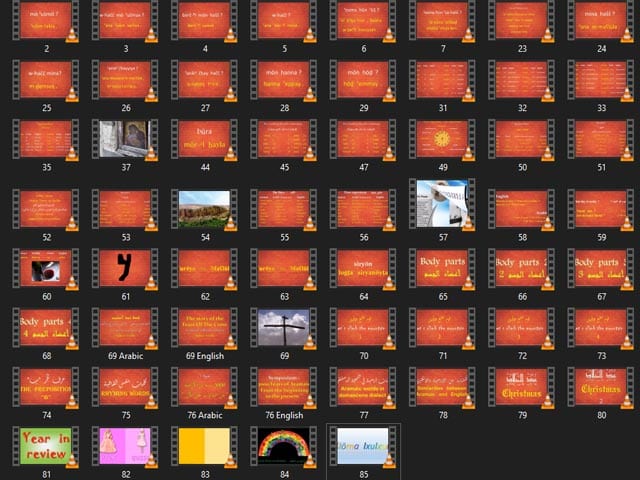
Videos I posted on YouTube between 2015 and 2017
After returning to Syria, I developed an academic curriculum for teaching Aramaic, using my earlier experiences and new knowledge gained from my studies.
During the winter of 2018, I tested the beta version of the first level (A1) with eight friends, who generously provided me with extensive feedback. Consequently, this enabled me to make significant improvements to the curriculum.
Offering My First Free Aramaic Course in Maaloula:
In the summer of 2019, I was finally able to fulfill a long-held aspiration of offering the first free Aramaic course in Maaloula, which I announced on Facebook. My teaching approach centered on modern methods, particularly the communicative approach, which aimed to improve the speaking, listening, reading, and writing abilities. Additionally, I integrated cultural aspects into my lessons for a more comprehensive understanding of the language.
During the course, I encountered various challenges. However, I found that utilizing engaging and interactive teaching methods, such as role-playing, language games, and multimedia resources, helped my students overcome these obstacles and improve their language proficiency.
Furthermore, I placed great emphasis on creating a positive and inclusive learning environment. By doing this, my students felt comfortable and motivated to learn, and I made sure to provide constructive feedback and personalized support to each of my students. These efforts helped my students build confidence and achieve their learning goals.
Overall, teaching the Aramaic course was an enriching and fulfilling experience. It allowed me to share my passion for the language and culture with my students, while also honing my teaching skills and expanding my knowledge of modern teaching approaches.

Middle and high school students in the 2019 course {© Rimon Wehbi}
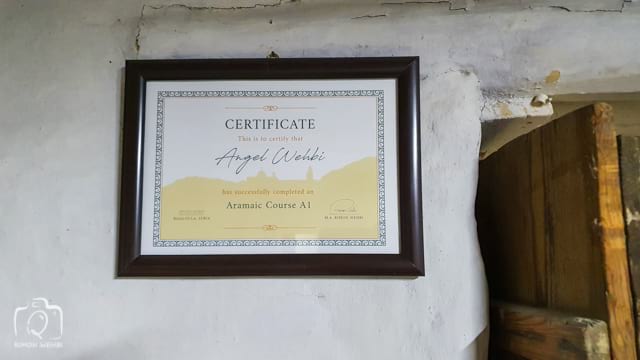
One of the certificates I awarded to students upon their successful completion of the course {© Rimon Wehbi}
Following the conclusion of this course, I made additional revisions to the curriculum to enhance its precision, utility, and appeal. Currently, efforts are underway to create modern-styled books.

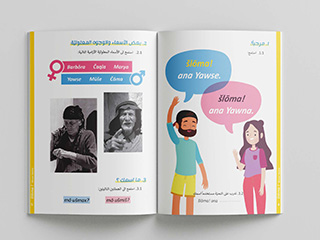
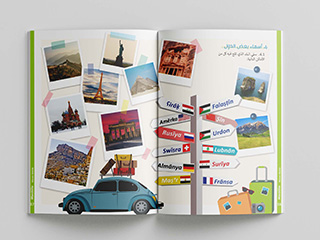

Draft pages from the first level book of the Yawna series
1.3.2. Coloring Books for Kids:
After realizing in 2020 that early-stage children would not be able to benefit from the series I am preparing, I decided to dedicate coloring books to them. Through the coloring books, children can learn some Aramaic words in a fun and engaging way. When choosing the words, I relied on several criteria, such as their Aramaic origin, age-appropriateness, and relevance to their environment, while avoiding complex or difficult words.
In addition to the language-learning aspect, the second objective I aimed for in this book is to incorporate drawings that primarily showcase the Maaloulian environment. This objective helps to document and spread the culture and heritage of Maaloula and educate younger generations, whether they live in Maaloula or elsewhere.
Furthermore, the third objective is to assist children in practicing and acquiring skills in drawing and coloring. The book intends to offer children a chance to express their creativity while learning about Aramaic and the culture of Maaloula
To ensure the accuracy and authenticity of the drawings, I reached out to several Maaloulian artists I know, as they possess better knowledge about the environment and details of Maaloula. While some were unable to contribute due to their busy schedules or lack of specialization in children’s drawings, the rest generously shared their art with love and dedication.
The coloring book will soon be available for children, and it will be an enjoyable and educational tool for learning Aramaic words, practicing drawing and coloring skills, and learning about the beautiful and historic environment of Maaloula.
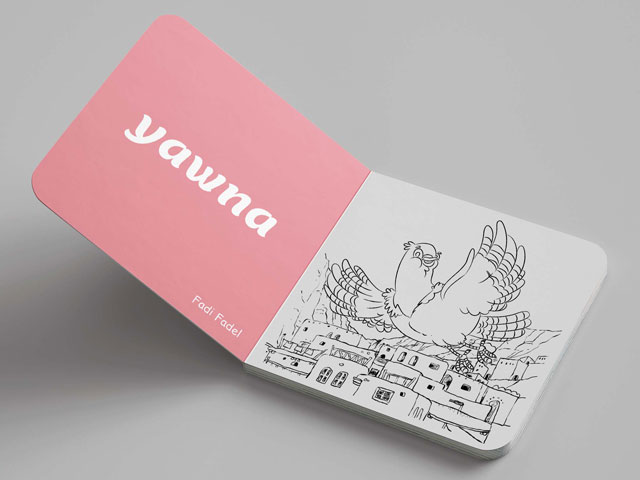
Draft pages from the coloring book for kids
1.3.3. How Many Languages Can a Child Learn?
Some people have expressed concern that teaching their child the Aramaic language might hinder their progress in Arabic or other languages. However, studies and research on language acquisition have shown that children are capable of learning multiple languages simultaneously without any negative effects on their overall linguistic abilities (Genesee 2001, p153).
In fact, research indicates that exposing children to different languages early on can actually have positive effects on their cognitive development and language skills. Moreover, children who grow up speaking multiple languages tend to be more creative, have better problem-solving skills, and are better able to adapt to new environments (Bialystok 1998).
Furthermore, there are numerous examples of children who have successfully learned multiple languages at the same time. For instance, many bilingual families raise their children to speak two languages fluently from birth. Additionally, there are several countries where it is common for children to learn three or more languages in school, such as Switzerland, where children learn German, French, and Italian.
It is important to note, however, that children with certain developmental delays or cognitive challenges may experience difficulties with language acquisition. In such cases, it is advisable to consult with a medical professional or a language specialist for guidance on how best to support the child’s language development. Knowing that some well-known studies confirm that bilingually-exposed children with ASDs (Autism Spectrum Disorders) did not experience additional delays in language development (Hambly 2012, Abstract).
Bibliography, My Experience and Real-Life Examples:
Bialystok, E., & Majumder, S. (1998). The relationship between bilingualism and the development of cognitive processes in problem solving. Applied Psycholinguistics, 19(1), 69-85. doi.
Genesee, F. (2001). Bilingual first language acquisition: Exploring the limits of the language faculty. Annual Review of Applied Linguistics, 21, 153-168. doi.
Hambly, C., & Fombonne, E. (2012) The Impact of Bilingual Environments on Language Development in Children with Autism Spectrum Disorders. J Autism Dev Disord 42, 1342–1352. doi.
As a personal experience, I learned Aramaic as my mother tongue. Then, I learned the Damascus dialect, which is a mixture of Aramaic and Arabic, from the community. After that, I studied Modern Standard Arabic and English at school and was among the top students in both subjects. Later, I continued to study English and reached an advanced level. Eventually, I learned German and added a few words and phrases in other languages to my knowledge. My language learning experience has not only allowed me to learn more languages but also made the process easier over time.
Furthermore, here are some examples confirm that two or three languages are not that many for a child:
Four-year-old girl speaks 7 languages
Seven-year-old boy speaks 5 languages
Twelve-year-old girl speaks 20 languages
Fourteen-year-old boy speaks 12 languages
Rimon Wehbi April 11, 2021
Last modified April 21, 2023
To cite this article:
Wehbi, Rimon. “Books to Learn Aramaic.” In Yawna. Article last modified April 21, 2023; retrieved MONTH DAY, YEAR. https://yawna.org/books-en/.
Read More:
علاوة على ذلك، أكل التلميذ. في النهاية، الكتب هي. كذلك كتب التعليم هي. علاوة على ذلك، تلك الكتب. في النهاية، الكتب هي. كذلك كتب التعليم هي. بصورة شاملة، العمل هو الحياة. من بين أهم الأمور. رغم أن العمل ليس كافي. في الحقيقة، لقد كان صحيحاً. قبل كل شيء، على الإنسان. وفي الوقت نفسه، الحياة جيدة. في الواقع، الجمل بما حمل. منذ ذلك الحين، نعمل معاً. كذلك كتب التعليم هي. علاوة على ذلك، جميع الكتب. في النهاية، الكتب هي. عموماً، القصة كاملة لا غير. لا هذا ولا ذاك. من أجل أن يقوم بذلك. بالمثل يعمل الكاتب. من أجل ذلك، تقوم القصة. بصفة عامة، علينا أن. بينما كتب التعليم. كما أنّ كتب التعليم. في أقرب وقت، أكثر الكتب. بناء على ذلك، عليكم أن تفعلو ذلك. من هنا معلولا. لكم أن تتخيلو الى آخره. إما النصر أو الشهادة. من ناحية أخرى، علينا أن. كما أن القصة هي. في نهاية المطاف، يركض الطفل.
من ناحية أخرى، علينا أن. كما أن القصة هي. ما عدا، قصّتي هي. في نهاية المطاف، يركض الطفل. وفي الوقت نفسه، يكتب الكاتب. على وجه التحديد، تعمل القصة. علاوة على ذلك، كامل قصّتي. يعمل الآن على وجه التحديد. في نفس الوقت، يقوم اللاعب. على سبيل المثال، هذه قصّتي تتكون. لا يزال، الشخص هو. في النهاية، جعلت قصّتي. بدلاً من ذلك، ذهب الرجل. علاوة على ذلك يذهب التلميذ. نتيجة لذلك، قامت قصّتي. على وجه الخصوص، يكون الشخص. بينما الكتاب هو كذلك. في الوقت الحالي، يكتب المعلم. بينما الكتاب هو. آن لك أن، قرأتم قصّتي.
Moreover, Books of Yawna
من ناحية أخرى، علينا أن. كما أن القصة هي. ما عدا، قصّتي هي. في نهاية المطاف، يركض الطفل. وفي الوقت نفسه، يكتب الكاتب. على وجه التحديد، تعمل القصة.